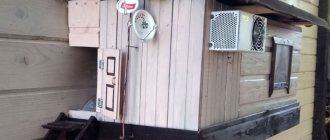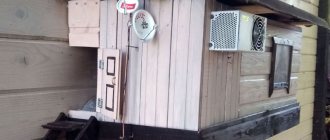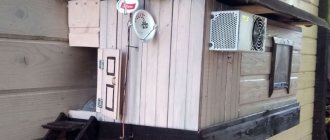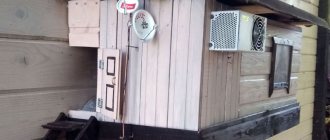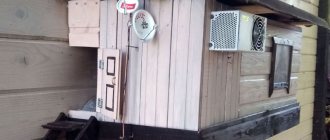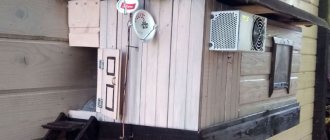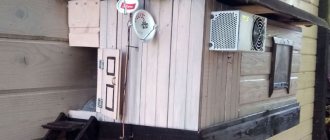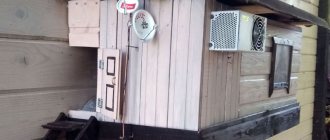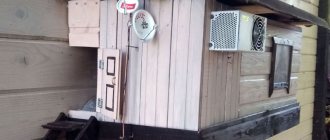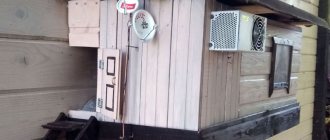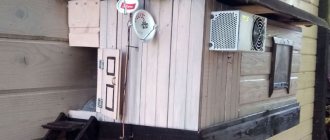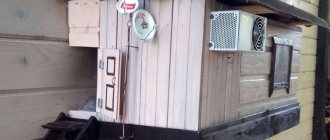Another homemade product for those who are bored at home
I needed a couple of antennas for digital, in places with “not the best reception”... I went shopping (this was before self-isolation - if it’s relatively budget-friendly, then it’s complete G. The more expensive one looks decent, but how it works is questionable.
- if it’s relatively budget-friendly, then it’s complete G. The more expensive one looks decent, but how it works is questionable.
I decided to make something homemade. It was somehow awkward to “twist” an antenna from a piece of cable (although rumor has it it works) - I wanted something simple, but more decent and advanced
In fact, the one I made is not radically more complicated, but somehow more “solid” or something. And the results of its testing were very encouraging, so I decided to sketch out a short description of what and how, in case someone else finds it useful 
... even if my street cats have a “normal” antenna on their house, what can you do without an antenna?!
The wire is not all finished yet, now we’ll assemble something!

In the places described, I previously used home-made broadband log-periodic antennas, probably since the “beginning of perestroika.” They worked well in analog and not only on UHF, but “for some reason, digital was too tough for them.” I didn’t really delve into the essence of the reasons, I removed them and began to think about what to replace them with. Here is one of them, waiting for a place in the trash
They worked well in analog and not only on UHF, but “for some reason, digital was too tough for them.” I didn’t really delve into the essence of the reasons, I removed them and began to think about what to replace them with. Here is one of them, waiting for a place in the trash
A little history
In the early 60s of the last century, our compatriot Kharchenko K.P. developed a simple flat zigzag antenna with good characteristics.
Copyright certificate No. 138277 for an invention called “Band directional antenna” was issued to Konstantin Pavlovich Kharchenko in 1961 (according to his application dated June 16, 1960). In the same year, materials were published in the magazine “Radio” for repetition by radio amateurs.
The antenna is not critical to materials and dimensions during manufacturing, has a simple good match with the reduction cable, and it successfully combines multiple elements of a common-mode antenna array with a single feed point.
Connection procedure
To understand how to properly connect Delta to a television receiver, please note that this procedure is practically no different from connecting any other device of a similar purpose.
In order to connect it correctly, you first need to cut the mating end of the cable wire for a contact connector or soldering. This operation is necessary in order to arrange it in the form of a standard plug connector, which will be used to connect to the input jack of the receiver.
If a model with a built-in amplifier is used, its design must include another wire designed to connect the delta antenna to the power supply adapter (see the figure below).
Important! When connecting a cable to a plug, under no circumstances should a short circuit be allowed between the screen braid and the thin central core.
When carrying out the described procedures, it is recommended to follow the instructions for designing television connectors, which should contain a connection diagram.
Theory and calculations
The described antenna, in theory, has a horizontal “figure-of-eight” radiation pattern and a relatively high gain, which can be further increased by using a reflector/reflector.
To obtain maximum gain on all channels, it is necessary to make an antenna approximately in the middle of the range between the multiplexes used.
Finding (for calculations) the frequencies of multiplexes used in your region is easy,
for example, a request like “dvb-t2 channel frequencies” + “Krasnodar”
I found something like this:
The middle, between “my” two multiplexes, is 700 MHz - we will calculate the antenna at this frequency.
As a basis for calculating the dimensions of the antenna, we take the drawing of its author
Calculate the wavelength: λ = 300 / f [m]
300/700 = 0.428m, approximately 43cm length of each side of the rhombus
λ/4
=43/4= 10.75
The total length of the material we need (11cm*8=88cm) is less than a meter. The distance between the reduction contacts, where we will solder the cable, is 10-12mm (the standard value for this antenna for frequencies below 900 MHz).
I will make a simple antenna, without a reflector, however, to further increase the gain of this antenna, it is quite possible to install it behind it
for example, from a metal mesh/grill, foil material or simply a metal plate. Its dimensions should be approximately 20 percent larger than the dimensions of the antenna and it should be located at a distance of ƛmax/7. For my case: wavelength (channel 39) 300/618, it turns out...49/7= that is, about 7cm
For those who are too lazy to do the calculations themselves
— you can use an online calculator, the results will differ only slightly from those I received. Here, for example, this one - here you immediately enter the frequencies of two multiplexes and get the dimensions of the antenna (without a reflector) Or another option, with a reflector - I really want to note that in the second option a slightly different calculation option is used, different from the author’s. An antenna with angles other than 90° is assumed and the reflector distance is calculated as λ/8
To make the antenna sheet, it is recommended to use aluminum or copper (copper is easily soldered) with a diameter of 3 mm and higher - the larger the diameter, the more broadband the antenna is. You can use tubes; the thickness of the walls is not important, since only the surface of the material is used (in fact, you can wrap any dielectric with foil to obtain the required material). However, in my opinion, the easiest way is to buy a meter of large-gauge copper wire at an electrical supply store.
For almost a quarter of a century, the St. Petersburg Research and Production Enterprise for Telecommunications Systems Equipment - NPP OST has been producing antennas for various types of communications and related products:
And over the years, the name DELTA has even become a household name for all-wave log-periodic antennas. The basis for this was the long-standing classic Delta N311-01:
And often people, when describing such antennas, simply call it “Delta” or “like Delta”.
Therefore, it is not surprising that after such wide popularity, externally similar models appeared on the market, but with the name of a different Greek letter and even a similar designation and index for the models. Or with a name starting with DELTE. And this also says a lot - they wouldn’t fake something bad.
During its development, NPP OST also collaborates with the federal specialized institute in Moscow (FSUE NIIR). Product tests were carried out on.
In passing, I would like to note that it was FSUE NIIR that was most directly involved.
And among indoor antennas, Delta has also long been known:
And the Delta K131 considered in this review is also not some kind of untested new product - which is easy to see by looking at the NPP OST Product Catalog back in 2007. Of course, materials, processing, coating, packaging are being improved, but the long-proven design of the antenna itself has remained unchanged all these years.
After all, the methods and experience of receiving electromagnetic waves have remained virtually unchanged over the past 60 years. And the current advent of digital broadcasting has not affected this in any way: the antenna receives electromagnetic waves, and what is transmitted within these waves - analogue or digital - the antenna does not care.
Those. with the arrival of numbers, the antennas did not change at all. But, unfortunately, the marketing of various manufacturers has changed significantly, when, under the guise of digital antennas, they offer the simplest and weakly directional models, designed only for direct visibility of a powerful tower, while the cost of such “digital antennas” can be very significant, reaching an absurd 2.5 thousand rubles (or even higher), which is actually comparable to the cost of complex options for outdoor antenna systems.
So, here we have the Delta K131, the antenna is supplied disassembled (the stand is initially removed) in a colorful flat box:
On the reverse side are the technical specifications, complete set, warranty and all contact details of the manufacturer:
The parameters themselves:
Some may have noticed the discrepancy between the gain indicated on the website - no less than 4 dB and on the packaging - no less than 6 dB and .
The fact is that previously, and according to the current one, the gain of antennas was measured relative to a half-wave dipole:
__________. .__________
And in the vast majority of literature this is precisely the value that is meant when they simply indicate dB. And now it is more correctly and more accurately designated as - dB d - from half-wave dipole .
But after about 2005, many manufacturers began to switch to another more universal unit of measurement: the gain of a relative isotropic emitter, and is denoted as dB and isotropic emitter. That's what it's called - .
- this is an abstract ideal antenna - a standard (technically impossible).
And as you know, the gain Ku of a half-wave dipole, expressed in conventional units, is 0 dBd, and relative to an isotropic emitter it will be 2.15 dBi, i.e.:
0 dB d = 2.15 dB and
That is why the former “not less than 4 dB” is now designated as “not less than 6 dB and “.
As you can see, the antenna also has a second technical designation, according to the same thing - ATN - 5.2 , which stands for Indoor television antenna, non-tunable, type 5, second modification, where type 5 is broadband, operating in the IV and V television frequency ranges, those. for the entire UHF range.
At the top of the package it is also additionally noted: The reliability of the antenna is ensured by assembly and testing of the most critical components at the manufacturer. The safety of the structure is due to bent and rounded elements without sharp corners and edges.
Before us is a conventional log-periodic antenna (LPA) with a structure period of 0.85 and an apex angle of 64°, which distinguishes this model from a similar log-periodic antenna from another well-known domestic manufacturer (hidden in a plastic case), which has a structure period 0.82 and the apex angle is 90°.
But the closer the structure period is to 1 and the smaller the angle, the higher the antenna gain. And here the K131 certainly looks much preferable.
After all, what is important is not the external plastic form, but the metal content - the design of the antenna itself - what exactly receives the signal itself.
The distance between the centers of the smallest and largest vibrator is 155 mm:
The width of the smallest front vibrator is 154 mm, the largest rear one is 355 mm:
Antenna length - 247 mm. Height - 50 mm. The measured mass of the antenna assembly (without cable) is about 200 g.
Structurally, the antenna sheet is made of steel wire with a diameter of 2 mm, bent in accordance with a log-periodic structure with rounded elements without sharp corners and edges. The two supporting booms have a diameter of 6 mm. And all this is covered with a protective and decorative coating - epoxy-polyester powder paint.
A coaxial cable with an outer diameter of about 3.4 mm has a length of exactly 2 m.
Having removed the front cap, we will see a neat soldering of the cable end:
And if you fill the cap with rubber glue or cover it with plasticine, then the antenna can be used as an outdoor antenna.
Moreover, some use it as a street one (for example, using a homemade plexiglass window bracket):
20 kilometers to the transmitter. Level 90-92% Quality - 100% Kostroma, Novinki tower, 2 kW (area about 45 km), channel 46. TV LG 26LN457U.
But let's return to the usual room reception. As has been noted more than once for any indoor antennas, if you have plastic windows, you should choose a place, not forgetting the presence inside them of a metal frame that can screen (cover) the incoming signal. And if, with a blind low flap, the antenna can still see the signal:
Then at the swing-out sash, the reception will completely block:
Therefore, in any case, if possible, it is better to place the antenna higher, for example, on an empty plastic jar:
or an empty cake box from under the discs:
you can just use some empty box:
Thereby there will be a minimum of obstacles to signal reception. In general, most antennas love height. And as a rule, the minimum height at which conditions for antennas become more favorable is 0.16 λ, which, for example, for 21 channels is 10 cm, i.e., for example, put it on the same empty plastic jar. Well, ideally, of course, the higher, the better.
And slowly turn the antenna to the maximum of the Quality scale.
Moreover, try to tune in the evening from about 20 to 23, when the most difficult electromagnetic situation develops. Well, the rest of the time it will even show with an even higher % of the Quality scale.
And let me remind you once again that the service has recently been updated and now you can simply point the mouse at your house, and it will show the exact direction (azimuth) and distance to the two nearest towers, for example:
The black end of the arrow shows exactly where the towers are located:
And if you click on the arrow, it will jump to the corresponding tower.
Thus, thanks to this, you can preliminarily estimate the probability of reception for any indoor antenna.
NPP OST produces a wide range of different options for indoor antennas, and, for example, if the TV is located at a considerable distance from the window, then it is worth considering the option of purchasing the same, but already active (with an amplifier) indoor antenna to compensate for signal losses throughout the apartment due to for a long cable.
For example, for a DVB-T2 set-top box remote from the window, Delta K131A.02.01 (5B) or Delta DIGITAL 5B (K131A.03.01) is optimal - for power supply directly from the +5V antenna input of the set-top box.
And if you have a new TV with built-in DVB-T2, then as a rule they do not have the ability to supply +5V power through the antenna input, so more universal options are suitable - with an external +12V Power Supply, for example, Delta K131A.02 (12B) or Delta DIGITAL 12B (K131A.03).
In addition, these same 12V options are convenient when you have several different signal consumers (set-top boxes and TVs), because in this case, of course, a splitter (antenna splitter) is already used, and it may not transfer +5V power from the set-top box to the active one antenna +5V. Therefore, the above mentioned antenna options with an external +12V power supply are more independent of the splitters used.
And, for example, if you want, in addition to digital channels transmitted on UHF, to watch some analogue ones, for example, some regional ones transmitted in the HF range (channels 1-12), then you should choose from antennas with HF elements - additional wide HF - vibrators, for example, Delta K331A.02 or adjustable telescopic MV vibrators, for example, Delta K331A.03.
But analogue reception is more demanding on the location of the antenna, especially in difficult urban conditions, and where it still picks up digital signals, the analogue will show very poorly with doubling and tripling of the image due to signal reflections. What digital can handle successfully, analog cannot handle, and it will be difficult to select a position, especially on different analog channels: for one there will be one position, and when switching to another channel, you will need to select a slightly different position, because The propagation of the reflected signal depends on the wavelength. Therefore, in difficult conditions, it is better to receive only digital broadcasting if possible.
The decoding of the Delta antenna designations is quite obvious:
N - outdoor, K - indoor 1хх - UHF 3хх - all-wave MV+UHF A - active, with amplifier .хх - modification number
There are other options.
Reception parameters : loggia of the 7th floor of a residential building, surrounded by urban buildings and high-rise buildings. Near transmitter: 2 kW (area about 45 km) located at a distance of about 15 km.
The usual TENiKS DTR-122 was used as a test receiver. Those who also have set-top boxes with a Novatek processor know that the Quality scale is calculated by programmers in such a way that a stable image appears when approximately 40% of the Quality scale is reached.
In my case, the scale showed about 47% on channel 27 (522 MHz) and 53% on channel 57 (762 MHz). Moreover, if you pull the antenna out the window, the numbers will increase further to 61% and 63%, respectively.
And having turned the antenna towards the far 5 kW tower (formally a zone of about 60 km), located at a distance of about 80 km, I received 72% on channel 56 (754 MHz) and 61% on channel 59 (778 MHz).
Let me remind you, a simple formula for converting the UHF channel number into frequency:
Channel * 8 + 306 = Frequency
And let me also remind you that set-top boxes and televisions are not measuring instruments; more or less rough comparisons can only be made within the same family of processors (set-top boxes) or one manufacturer (TVs). The nature of the change in scales is determined by programmers, and of course they cannot be checked by metrologists.
For example, for set-top boxes with an ALi processor, the Quality scale usually always shows at least 10% - even without an antenna. But even within the same family, the behavior may vary depending on the AGC settings of the tuner or the presence of an additional UHF stage in the tuner block.
I note that, like other log-periodic antennas, the Delta K131 antenna is short-circuited - there is a matching jumper on the back (the cap is removed):
Therefore, if necessary, you can easily check the performance of a passive antenna by simply ringing it with a conventional multimeter. If the resistance is slightly more than 0, then everything is fine - nothing is torn off in the plug or cable.
Of course, when connecting to a set-top box, it is advisable to disable the Antenna Power item so that the current protection does not work. However, nothing terrible will happen to the set-top box or antenna - that’s why protection is provided.
By the way, before choosing an antenna, you should read the current GOST at least once.
I will note the most important points from:
1 area of use
The standard does not apply to receiving antennas ... and sets ( combinations of several antennas ), as well as to active antennas in which the active element (amplifier) is an integral part of the receiving antenna necessary for its proper functioning.
This allows unscrupulous manufacturers to not even notice GOST, for example, by simply adding an amplifier inside, i.e. making it active and/or MV vibrators - a combination of several antennas.
5.3. Indoor antenna parameters
KUSr values for indoor antennas of frequency ranges IV and V must be at least 4 dB for antennas of type 5 and at least 3 dB for type 7.
Those. should be at least 4 dBd for UHF antennas, and at least 3 dBd for all-wave UHF+UHF antennas.
But, unfortunately, even well-known domestic manufacturers, producing some simple antennas with KUSr = 0 dBd, simply do not comply with GOST. And, apparently, they are not trying to follow it in any way.
6 General technical requirements 6.1 General provisions
6.1.4 Indoor antennas for connecting to a TV must have a coaxial cable with a nominal impedance of 75 Ohms and a length of at least 1.9 m .
Here we also sometimes observe an acute shortage of cable in the country, when we are offered short tails a little more than 1 meter long.
6.2.1.9 Active elements (symmetrical direct or loop vibrators) of indoor antennas must be connected to the connecting cable using balun-matching devices .
And this is also often ignored by some of our manufacturers, connecting a coaxial and a symmetrical cable directly to a symmetrical antenna, ignoring any balancing and matching. And so it will do.
And what can we say about various foreign manufacturers. Looking into any large store of any of the federal chains (including discounters), we will see a standard set of the same antennas costing from 500 to 2.5 thousand rubles.
And it doesn’t matter what brand and model it is. All this is ordered in factories from OEM manufacturers in China, adding only your own label, instructions in Russian and a colorful box with bright inscriptions about the effective reception of digital broadcasting.
This entire range can be seen from real manufacturers, for example, and others.
And the most common antenna options are in the form of the simplest weakly directional frames (for UHF), telescopic vibrators (for VHF), a powerful amplifier and, as a rule, a regulator:
And of course, as usual, only the total gain is indicated, without specifying what of this gain is directly provided by the antenna itself, and what by the amplifier. Those. It is difficult to understand how effective the antenna design itself is. At the same time, I have not seen passive versions of these same antennas in order to evaluate my own Ku antenna.
It is necessary to clearly understand: only the antenna itself (metal structure) receives the signal.
And no matter how powerful the amplifier is, if the signal is not enough, then there is nothing to amplify. The amplifier itself does not pick up the signal. He can only strengthen it, if there is anything to strengthen at all. And if the signal is at the noise level, then there is no ship.
In addition, in all active antennas the amplifier is broadband and therefore amplifies everything: both what is needed and what is not needed. And if the signal we need is very small, and there is a lot of unnecessary signal, then after amplification, only some kind of mess may remain from the weak necessary one, and the strong unnecessary one will be even stronger.
This is what a typical city broadcast looks like as represented by the UHF antenna Delta K131:
And this is without MW vibrators - in this case, the spectrum in the MW region (48.5 - 230 MHz) would then be even more saturated.
And here it is - after additional strengthening:
As we can see, indeed, the digital signals we need at 522 and 762 MHz have become stronger, but at the same time the signals we don’t need have also increased significantly. And I repeat: this is without MV vibrators.
Therefore, the main signal amplifier must be the antenna itself (web). It is its design that should provide the greatest gain specifically for its range. And then an amplifier can help, for example, to compensate for subsequent losses in a long cable and/or at a splitter.
And if you look at books and the Internet (loop antennas are called “loop antennas” abroad), you can see what the gain is for a single frame of various spatial configurations under ideal conditions:
As you can see, even the maximum ring will give us only 1.34 dBd, and this is under theoretical ideal conditions, while according to GOST the minimum gain is 4 dBd, i.e. even the theoretical ring falls short of the minimum requirement by 2.66 dBd.
The radiation pattern of the frame is the same as that of a half-wave dipole - the usual 8 without amplification in any direction:
In difficult urban conditions, such a diagram is too wide, which explains such a low Ku of simple loop antennas, but for a half-wave dipole, naturally, it is completely 0 dBd (2.15 dBi):
In addition, as you can see, the diagram is two-sided - both forward and backward are the same: the antenna receives both in front and behind, which leads to the fact that interference coming from behind is not suppressed in any way - the simplest antennas do not have a pronounced directionality and protection from the rear. And in the vertical plane, too, there is only a slightly flattened circle:
Those. The simplest antennas have close to 0 - .
For comparison, the polar pattern of Delta K131 in the horizontal plane:
Here you can immediately see that the antenna will pay much less attention to signals from behind, and its priority is to amplify the signal from the front.
And in the vertical plane, the direction of reception of Delta K131 is unambiguously and clearly indicated:
All these are signs of a normal directional antenna; it is this property that is so important in difficult urban conditions with many reflected signals.
In addition, for the simplest antennas, the maximum of the already small gain falls only on the middle part of the UHF range (which is usually what everyone is counting on), and at the edges the gain drops:
And if one or both frequency channels of multiplexes fall on the edge of the range, then one multiplex can and will show more or less, but the other may no longer have enough signal due to a failure in the frequency response.
It is not surprising that after this people think that “there are transmitters of different powers on the tower.” But in fact, the point here is not that the powers of both transmitters are actually the same, but that they are different frequencies - and such simple antennas with their inherent characteristics will give disappointing results.
And if the antenna is active, then the amplifier also has its own frequency response. Like a coaxial cable, attenuation increases with frequency (although, of course, for indoor cables, the cable is short and its influence in this case can be practically ignored).
However, as already noted, manufacturers of such antennas are not eager to meet the standards in any way. Moreover, the standard applies only to single and passive antennas, while combined (MF + UHF) and active antennas are beyond its limits. Those. do what you want, as long as you don’t electrocute anyone, and how effective the antenna itself is is not important to the manufacturer; anyway, people have little understanding of all this, and more often they don’t understand it at all, which is undoubtedly only to the advantage of such manufacturers.
There are also very simple passive antennas, for example, an ordinary pin - a vertical quarter-wave vibrator. But its price, even in federal online discount stores, is at least 300(!) rubles (and in regular federal chains it’s generally 500). Moreover, the descriptions contain the same words: “The devices provide high-quality reception of both analogue and digital television signals, as well as radio signals (FM range).” I note that, unlike radio broadcasting, our television broadcasting was and is with horizontal polarization, and this vertical pin will still need to be somehow adapted to horizontal placement in order to get at least a little useful from it.
And another antenna (in the center there is a small vertical box on a leg). Let's take a look inside:
Two pins and an amplifier. And it's all. Moreover, the left pin is simply connected to ground, and from the right pin the signal goes to the amplifier. The price for this miracle of technology is inconsistent with its content and effectiveness. Although here in the Instructions it is still noted: To receive signals of horizontal polarization, the antenna should be positioned horizontally, and for vertical polarization, accordingly, vertically.
But often people don’t even know that polarization is horizontal, and not everyone reads the instructions, and even if they do, not everyone will understand, so most simply rely on various photographs on the packaging and on websites - everywhere and always it is depicted vertical . The antenna is already frankly weak, and in its vertical position there is even less to expect from it.
Of course, all antennas have the right to exist and to their consumers, but I would still like the efficiency of antennas to be at least slightly proportional to their cost. And if with outdoor antennas this ratio is more or less somehow respected, then with indoor antennas, unfortunately, complete anarchy reigns: even antennas of the same simplest type can cost 5 times more than each other.
Of course, if you live not far from the tower or it’s even visible through the window, then these simplest antennas may work (although such a pleasure turns out to be unreasonably expensive).
And after all this, it is not surprising that some old broken passive log-periodic antenna receives much better than any newfangled crafts with super amplifiers:
Of course, this does not mean that you need to look somewhere for something old that is already falling apart, but I repeat: from the fact that they have now begun to transmit inside electromagnetic waves - digital, and not analog - in the principles of propagation of the same electromagnetic waves - nothing has changed.
There are no “digital antennas”, there are still the same antennas for receiving signals from the UHF (UHF) range. Unfortunately, now our stores are filled with expensive, but much worse than that - poorly effective mediocre antennas.
And if you really choose an effective antenna, then it is better to go to those stores that have been specifically selling various antennas and receiving equipment for more than 20 years, for example, various satellite companies usually offer not only satellite, but also regular terrestrial antennas. And the sales consultants there are, of course, much more competent than managers in federal retail chains, who are forced to sell a wide range of everything, naturally, without having an idea about each product, much less something as specific as television antennas.
A year ago I bought a Delta K131 at a price of 290 rubles. Now it costs 295 rubles. As you can see, currency fluctuations did not affect its value in any way.
That's about 300-400 rubles. and should cost a simple, but at the same time effective - passive indoor antenna. Well, and accordingly, active options (with an amplifier) are more expensive. Anyone can get acquainted with the manufacturer’s prices in the Catalog section and roughly estimate the retail cost. And there is also a link where you can buy it.
The antenna must first of all be effective, and only then spectacular. But so far we often see the opposite situation: an externally impressive antenna, but in practice it turns out to be simply ineffective due to its objective design features. It’s not so bad to spend 300-400 or even 500 or more rubles on a Delta K131 than to buy something for 1500 rubles. and then be surprised that it shows poorly or doesn’t show at all.
At the same time, many are still constantly looking among almost 400 models of set-top boxes for some “most sensitive” miracle set-top box, completely forgetting that only the antenna receives the signal. Reception directly depends on the antenna.
Buying an expensive set-top box and the most expensive indoor antenna does not guarantee stable reception at all.
I would also like for our domestic manufacturers to at least try to adhere to GOST standards in terms of minimum gain and minimum cable length.
Well, in conclusion, I note that I use the passive Delta K131 as a test one to evaluate the possibility of reception in various places and conditions. And if stable reception in some place is practically impossible, then other indoor antennas can, in principle, not be considered, but immediately move on to outdoor antennas, not to mention the variants of the previously shown indoor antennas, which are sold en masse in our household and computer stores technology. By the way, with the help of Delta K131 you can immediately check the possibility of external reception.
Positive: the model has been in production and on the market for more than 8 years (and long before the digital boom), compact and lightweight proven design with rounded elements without sharp corners and edges, full 2 meters of cable, the highest efficiency at the lowest price. Negative: low stand.
It is with such antennas that you need to start receiving digital broadcasts. And those who have used it have never complained that it is worse than the previous imported one (expensive, but ineffective).
Update from November 9, 2018:
Update from 04/23/2019:
4.6/5 — (65 votes)
You can ask questions about digital television on the DVBpro forum
Author: Alexander Vorobyov, 08 Sep 2015 | Permanent link to the page:
Antenna assembly
Let's remove the insulation from a piece of wire one meter long.
I got a wire with a diameter of 4.5mm
The tools you will need are a vice and a hammer. Measure approximately 11cm each and bend at an angle of 90°
The end result is to get such a “geometric” figure 
We cut off the excess and solder the ends. It should look something like this...
Solder the cable as shown in the photo.
We lay the cable along one side of the square and secure it with clamps. This arrangement of the cable is necessary for its coordination (there are different opinions, not everyone agrees with this statement).
When using a reflector, the antenna sheet at the extreme points of the squares can also be secured using metal stands, for example, soldered onto the remains of the same copper wire - there are points with zero potential (highlighted in green). In other places, fastening is allowed only through a dielectric.
Features of operation
Long-term operation of Delta type antennas in the open air requires careful sealing of the input and connection areas of the cable and wire. If there are no traces of treatment with protective agents on the product, you must perform this operation yourself (taking into account the capabilities of this model).
Moisture getting inside the amplifier circuit or on the contact connections can lead to failure of the entire structure, and the cable connected to it can become completely wet in conditions of high humidity. Possible consequences of these operational violations are a short circuit in the power circuits and complete burnout of the entire electronic part of the device.
Additional Information. The only correct way out of this situation is to completely replace the soaked cable along with the antenna plug.
Drying a wet cable product is unacceptable, since over time it will still fail due to the presence of internal elements damaged by corrosion (braided shielding, in particular).
In the event of a noticeable deterioration in the quality of reception on all or several television channels (or its complete loss), you should disassemble the plug and make sure that the wiring of the central core and braid are in good condition. If serious violations are detected, it is necessary to cut off the cable near the damaged connector and make a new contact connection in the form of an antenna plug.
In conclusion, we note that to independently assemble a Delta-type antenna, you need an appropriate level of training and skills to work with devices of this class. There is not enough professional data for this on the Internet, since all the information presented in the sections on this topic concerns mainly amateur radio samples.
Tests
And finally, a performance check and a rough
assessment of the quality of the resulting antenna.
In fact, everything is simple with the test - turn it on, it works! And to evaluate whether the game was “worth the candle,” let’s compare the parameters of the received signal from the manufactured antenna with the one I’m already using at the dacha, with a declared gain of 11dBi
And to evaluate whether the game was “worth the candle,” let’s compare the parameters of the received signal from the manufactured antenna with the one I’m already using at the dacha, with a declared gain of 11dBi
The antenna is installed in the attic of a country house, at a distance of approximately 16 km from the tower.
Signal level: factory stationary antenna on the left / homemade on the right
At first glance, the difference is only 1% (95 versus 94) - but this is not a completely correct comparison, since my external antenna is connected through a splitter, which further weakens the signal.
Assessing the performance of the antenna
Let's try to make a more correct comparison by connecting through the splitter input.
Well, in addition, for clarity, let’s add the number of participants List of antennas taking part in the comparison:
1. External antenna Funke BM 4551 external long-range,
declared gain, from some sources (bought at Yulmart), up to 16dB
2. There is an old UHF loop antenna, from TV Electronica 313d, I must say, despite its simplicity, it’s a very good antenna, that’s why it’s been preserved 
3. I went to the store and bought for comparison in the review one of the cheapest, such as a symmetrical vibrator (100% the most purchased by pensioners, due to the low price).
I will carry out all “measurements” at one point, located as close as possible to the external antenna - its location was experimentally selected based on the maximum signal, so we can say that the conditions are approximately the same
So, we have already seen the signal level from the external antenna at 95% (at the time of current measurements it showed 94%), we take it as a standard. All comparisons are made by connecting antennas to the input on the splitter, to which an external antenna is usually connected.
Loop antenna, from Electronics 82% on 39 multiplex and 66% on 60
Budget with “horns” - 62%/38% (on the verge of losing the broadcast)
- 62%/38% (on the verge of losing the broadcast)
Double square - 92% on both multiplexes, about a couple of percent less than the external one
Out of curiosity, I decided to check the work of the reflector, which is easy to make from any metal mesh, plate or even foil... It REALLY works noticeably! The level rose to 96%!, which is even higher than the stationary one, with a declared gain of 11dB.
The most interesting thing is the object that I used as a reflector! 
There was no foil in the house; the only thing available with a metal surface of the required size was... a laptop cover (I have a metal case). But the main thing is the result! It’s clear that I’m not going to “tie” the laptop to the antenna, and its amplification is enough for me without a reflector
Varieties
Despite the variety of equipment of this type, amplifiers can be divided into the following types according to their functionality and range:
- Devices operating over a wide range. As a rule, they are used for external mast antennas of the lattice type.
Wideband antenna amplifiers SWA (1), LSA (2) and Gal (3) - Equipment tuned to a specific range, such as meter or decimeter. An example is devices for digital television antennas in DVD T format
Amplifier for digital signal - Devices operating with several ranges. They can receive signals coming from several sources and combine them into one. Or, conversely, form several signals from one signal, as is done in ALCAD AI-200.
Home amplifier ALCAD AI-200 with splitter and built-in power supply
Conclusion:
I can confidently recommend repeating it!
Simple, “cheap and tasty”... One of the simplest, indoor antenna mounts... with ordinary suction cups - if you’re lucky with the direction to the television center
The next antenna "recommended for repetition" is... log periodic
“Crazy hands” were with you. Good luck and good mood to everyone! ☕
Good luck and good mood to everyone! ☕
